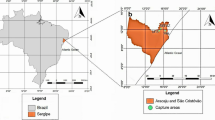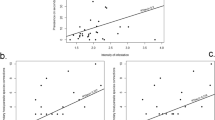Abstract
The objective of the present paper is to extend the knowledge of roosting strategies of bats and the interaction of bats with their roost ectoparasites, the bat bugs Cimex pipistrelli. The project was focussed on the potential causality of bat movements and the variation in bug numbers. For 2 years, three model bat boxes with breeding female Pipistrellus pygmaeus were monitored inside floodplain forest. After the arrival of bats in May, adults and first instars of bugs were observed in the boxes. During the lactation period in June, when the bats did not occupy the roosts, the first instar bugs died out followed by the adults. The decrease in bug numbers began only several days after the bats had left the boxes. After a month of the bats’ absence, the abundance of adult bugs decreased by half of their number. Only the eggs survived the period when the roosts were unoccupied in summer. In mid-July, after the arrival of lactating females, an increase in the number of bugs was observed. At the beginning of August, however, no new eggs were found. Although adult C. pipistrelli are able to survive the winter period in the boxes, the bats, by shifting the roosts within the vegetation season, prevent the massive reproduction of these parasites.


Similar content being viewed by others
References
Aukema B, Rieger C (1995–1996) Catalogue of the heteroptera of the Palearctic region. Nederlandse Entomologische Vereiniging, Wageningen
Bartonička T, Řehák Z (2007) Influence of the microclimate of bat boxes on their occupation by the soprano pipistrelle Pipistrellus pygmaeus: possible cause of roost switching. Acta Chiropt (in press)
Brigham RM, Vonhof MJ, Barclay RMR, Gwilliam JC (1997) Roosting behaviour and roost-site preferences of forest-dwelling California bats (Myotis californicus). J Mammal 78:1231–1239
Christe P, Arlettaz R, Vogel P (2000) Variation in intensity of a parasitic mite (Spinturnix myoti) in relation to the reproductive cycle and immunocompetence of its bat host (Myotis myotis). Ecol Lett 3:207–212
Davis MT (1964) Studies of the reproductive physiology of Cimicidae (Hemiptera). I. Fecundation and egg maturation. J Insect Physiol 10:947–963
Dietz M, Walter G (1995) Zur Ektoparasitenfauna der Wasserfledermaus (Myotis daubentonii Kuhl, 1819) in Deutschland unter der besonderen Berücksichtigung der saisonalen Belastung mit der Flughautmilbe Spinturnix andegavinus Deunff, 1977. Nyctalus 5:451–468
Estrada-Peña A, Serra-Cobo J (1991) The acarinia and nycteribidia zones of Miniopterus schreibersii Kuhl (Mammalia: Chiroptera) in the northeast of Spain. Folia Parasitol 38:345–354
Estrada-Peña A, Peribáñez MA, Serra J (1991) The life cycle of Spinturnix psi (Mesostigmata: Spinturnicidae) on Miniopterus schreibersii (Mammalia: Chiroptera). In: Dusbábek, Bukva V (eds) Modern acarology, vol 2. Academia, Prague, pp 475–480
Feyerabend F, Simon M (2000) Use of roosts and roost switching in a summer colony of 45 kHz phonic type pipistrelle bats (Pipistrellus pipistrellus Schreber, 1774). Myotis 38:51–59
Gaisler J (1966) A tentative ecological classification of colonies of the European bats. Lynx n.s. 6:35–39
Giorgi MS, Arlettaz R, Christe P, Vogel P (2001) The energetic grooming costs imposed by a parasitic mite (Spinturnix myoti) upon its bat host (Myotis myotis). Proc Biol Sci 268:2071–2075
Hase A (1917) Die Bettwanze (Cimex lectularius L.) ihr Leben und ihre Bekämpfung. Monographien zur angewandten Entomologie IV, 1. Verlagsbuchhandlung Paul Parey, Berlin
Hamilton IM, Barclay RMR (1994) Patterns of daily torpor and day roost selection by male and female big brown bats (Eptesicus fuscus). Can J Zool 72:744–749
Hůrka L (1988) Die Zwergfledermaus (Pipistrellus pipistrellus) (Mammalia: Chiroptera) in Westböhmen. Folia Mus Rerum Nat Bohem Occident Plzeň 27:1–31
Johnson CG (1940) Development, hatching and mortality of the eggs of Cimex lectularius L (Hemiptera) in relation to climate, with observations on the effects of preconditioning to temperature. Parasitology 32:127–173
Johnson CG (1942) The ecology of the bed-bug, Cimex lectularius L., in Britain. J Hyg 41:345–361
Jones RM (1930) Some effects of temperature and humidity as factors in the biology of the bedbug (Cimex lectularius Linn.). Ann Entomol Soc Am 23:105–119
Kemper H (1936) Die Bettwanze und ihre Bekämpfung. Z Kleintierk Pelztierk 12:1–107
Kerth G, König B (1999) Fission, fusion and nonrandom associations in female Bechstein’s bats (Myotis bechsteinii). Behaviour 136:1187–1202
Kerth G, Weissmann K, König B (2001) Day roost selection in female Bechstein’s bats (Myotis bechsteinii): a field experiment to determine the influence of roost temperature. Oecologia 126:1–9
Lewis SE (1995) Roost fidelity of bat: a review. J Mammal 76:481–496
Lewis SE (1996) Low roost-site fidelity in pallid bats: associated factors and effect on group stability. Behav Ecol Sociobiol 39:335–344
Lourenço SI, Palmeirim JM (2005) Influence of temperature in roost selection by Pipistrellus pygmaeus (Chiroptera): relevance for the design of bat boxes. Biol Conserv 119:237–243
Lučan R (2006) Relationship between the parasitic mite Spinturnix andegavinus (Acari: Spinturnicidae) and its bat host, Myotis daubentonii (Chiroptera: Vespertilionidae): seasonal, sex- and age-related variation in infestation and possible impact of the parasite on the host condition and roosting behaviour. Folia Parasitol 53:147–152
Mellanby K (1932) Effects of temperature and humidity on the metabolism of the fasting bed-bug (Cimex lectularius). Parasitology 24:419–428
Omori N (1941) Comparative studies on the ecology and physiology of common and tropical bed bugs, with special references to the reactions to temperature and moisture. Journal of the Medical Association of Taiwan 60:555–729
Péricart J (1972) 7. Hémiptères anthocoridae, cimicidae et microphysidae de l’Ouest-Paléartique. Faune de l’Europe et du Bassin Méditerranéen. Mason et Cue Édit., Paris
Péricart J (1996) Family cimicidae. In: Aukema B, Rieger Ch (eds) Catalogue of the heteroptera of the Palearctic region. Nederlandse Entomologische Vereiniging, Wageningen, pp 141–144
Povolný D (1957) Kritická studie o štěnicovitých (Het. Cimicidae) v Československu. (A critical study on bugs (Heteroptera, Cimicidae) in Czechoslovakia). Zool Listy 6:59–80 (in Czech with a summary in Russian)
Reinhardt K, Siva-Jothy MT (2007) Biology of the bed bugs (Cimicidae). Annu Rev Entomol 52:351–374
Ritzi CM, Whitaker JO Jr (2003) Ectoparasites of small mammals from the Newport chemical depot, Vermillion county, Indiana. Northeastern Naturalist 10:149–158
Ritzi CM, Ammerman LK, Dixon MT, Richerson JV (2001) Bat ectoparasites from the Trans-Pecos region of Texas, including notes from Big Bend National Park. J Med Entomol 38:400–404
Rivnay E (1932) The influence of relative humidity upon the rate of development of the bed bug C. lectularius L. Bull Soc Roy Entomol d’Egypte 16:13–16
Ryckman RE, Bentley DG, Archbold EF (1981) The Cimicidae of the American and oceanic islands. A checklist and bibliography. Bull Soc Vector Ecol 6:93–142
Swift SM (1980) Activity patterns of pipistrelle bats (Pipistrellus pipistrellus) in north–east Scotland. J Zool Lond 190:285–295
Thomas DW (1995) Hibernating bats are sensitive to nontactile human disturbance. J Mammal 76:940–946
Thompson MJA (1990) The pipistrelle bat Pipistrellus pipistrellus Schreber on the Vale of York. Naturalist 115:41–56
Usinger RL (1966) Monograph of Cimicidae (Hemiptera–Heteroptera). Thomas Say Foundation, vol 7. Entomological Society of America, New York
Vonhof MJ, Barclay RMR (1996) Roost-site selection and roosting ecology of forest-dwelling bats in southern British Columbia. Can J Zool 74:1797–1805
Walter G (1996) Zum Ektoparasitenbefall der Fledermäuse und den potentiellen Auswirkungen. Myotis 34:85–92
Webb PI, Speakman JR, Racey PA (1996) Population dynamics of a maternity colony of the pipistrelle bats (Pipistrellus pipistrellus) in north–east Scotland. J Zool Lond 240:777–780
Wendt A (1941) Familie Cimicidae Latreille, 1804. In: Gulde J (ed) Die Wanzen Mitteleuropas. P. O. H. Werde, Frankfurt a. M, pp 119–131
Whitaker JO (1998) Life history and roost switching in six summer colonies of eastern pipistrelles in buildings. J Mammal 79:651–659
Whitaker JO, Mumford RE (1978) Food and ectoparasites of bats from Kenya, East Africa. J Mammal 59:632–634
Whitaker JO Jr, Deunff J, Belwood JJ (2000) Ectoparasites of neonate Indiana bats, Myotis sodalis (Chiroptera: Vespertilionidae), with description of male of Paraspinturnix globosa (Acari: Spinturnicidae). J Med Entomol 37:445–453
Willis CKR, Brigham RM (2004) Roost switching, roost sharing and social cohesion: forest-dwelling big brown bats (Eptesicus fuscus) conform to the fission–fusion model. Anim Behaviour 68:495–503
Wolz I (1986) Wochenstuben-Quartierewechsel bei der Bechsteinfledermaus. Z Säugetierk 51:65–74
Acknowledgments
The authors are indebted to R. Obrtel (Brno) for both his revision of the English and his comments on the study from an entomologist’s point of view. The study was supported by grant no. MSM 0021622416 of the Ministry of Education, Youth and Sports of the Czech Republic, grand no. 206/07/P098 of Science Foundation of the Czech Republic and the Czech Bat Conservation Trust. The boxes were checked under the licence no. 922/93-OOP/2884/93 of the Ministry of Environment of the Czech Republic. The authors were also authorized to handle free-living bats according to the certificate of competency no. 104/2002-V4 (Section 17, Law no. 246/1992).
Author information
Authors and Affiliations
Corresponding author
Rights and permissions
About this article
Cite this article
Bartonička, T., Gaisler, J. Seasonal dynamics in the numbers of parasitic bugs (Heteroptera, Cimicidae): a possible cause of roost switching in bats (Chiroptera, Vespertilionidae). Parasitol Res 100, 1323–1330 (2007). https://doi.org/10.1007/s00436-006-0414-6
Received:
Accepted:
Published:
Issue Date:
DOI: https://doi.org/10.1007/s00436-006-0414-6




